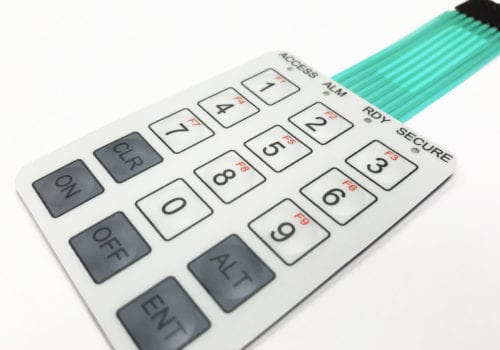Key Benefits of Using a Membrane Switch in Industrial Applications
Key Benefits of Using a Membrane Switch in Industrial Applications
Blog Article
Exactly How Membrane Layer Switches Add To the Sturdiness of Electronic Control Panels
Membrane layer buttons play a vital role in boosting the durability of electronic control panels, mainly through their multi-layered construction which gives reliable protection versus environmental elements such as dampness and dirt. The absence of moving components substantially decreases the likelihood of mechanical failings, making membrane layer changes perfect for demanding applications.
Definition of Membrane Layer Switches

Membrane layer buttons are created to be slim and lightweight, making them suitable for applications where area is restricted. They can be made in different forms, dimensions, and shades, offering versatility in style that fulfills aesthetic and functional demands. Furthermore, membrane layer buttons can include different technologies, such as responsive comments and LED indicators, enhancing user experience.
Because of their construction, membrane buttons are often immune to dirt, wetness, and general wear, adding to their durability popular environments. Their seamless layout not only promotes simple cleaning but additionally lessens the threat of mechanical failure, making them a favored option for manufacturers looking for reputable individual interfaces in their digital control board.
Protection Versus Environmental Elements
The layout of membrane layer switches inherently offers a degree of defense versus different environmental factors, which is vital for maintaining capability in difficult conditions - Membrane Switch. These buttons are normally created with layers of versatile products that secure internal parts from moisture, dust, and impurities. By encapsulating the circuitry, membrane changes lessen the risk of brief circuits and corrosion, which can substantially harm performance
Moreover, using robust adhesives and sealants during manufacturing enhances their resistance to environmental obstacles. Membrane buttons can endure exposure to chemicals and solvents, making them ideal for sectors such as food handling and health care, where health and tidiness are extremely important. Their seamless surface layout also prevents the accumulation of dust and bacteria, facilitating simpler cleansing and upkeep.
Temperature variations are an additional ecological problem, and membrane layer buttons are engineered to operate successfully across a vast array of temperature levels (Membrane Switch). This adaptability makes sure that control panels continue to be operational in various setups, from industrial environments to customer electronics
Effect On User Interaction
Individual interaction with electronic control panels is dramatically affected by the design and performance of membrane buttons. These buttons supply a tactile interface that boosts the general customer experience, enabling instinctive navigating and control. Their receptive nature guarantees that individuals get prompt responses upon activation, which is crucial for tasks calling for accuracy and performance.
Additionally, the smooth surface of membrane layer switches over helps with very easy cleaning and upkeep, promoting individual confidence in the reliability of the user interface. This tidiness is check it out specifically crucial in settings where hygiene is critical, such as clinical or food processing setups. In addition, the small and light-weight design of membrane switches adds to the visual allure of control panels, urging user engagement through a modern and streamlined look.
Furthermore, the integration of visual elements, such as published icons and backlighting, helps customers rapidly identify functions, lowering the learning curve related to new devices. As an outcome, customers can operate tools better, causing enhanced performance and contentment. In summary, membrane layer switches play an essential function in enhancing individual interaction by combining functionality, aesthetics, and simplicity of usage, ultimately leading to enhanced operational efficiency.
Style Flexibility and Customization
Style versatility and customization are crucial facets of membrane buttons, enabling producers to tailor electronic control board to certain applications and individual requirements. This adaptability enables the integration of various style aspects, such as shades, graphics, and appearances, which can boost the aesthetic charm and user interaction of the control panel.
Membrane buttons can be tailored in size and form, suiting a large range of tools and applications, from industrial machinery to customer electronic devices. This versatility guarantees that manufacturers can develop intuitive interfaces that line up with customer expectations and functional demands. Furthermore, the ability to integrate one-of-a-kind attributes such as backlighting or tactile comments even more enhances usability, permitting for a much more interactive experience.
Furthermore, the helpful hints manufacturing procedure for membrane changes sustains the fast prototyping of styles, enabling makers to iterate and fine-tune their concepts swiftly. This capacity not just speeds up the growth timeline but additionally guarantees that website here the final product fulfills particular functional and aesthetic criteria.

Cost-Effectiveness and Durability
Cost-effectiveness and longevity are significant advantages of membrane layer switches, making them an appealing choice for suppliers and end-users alike. These switches are generally less costly to generate than standard mechanical switches, mainly as a result of their streamlined manufacturing processes and the lowered number of elements required. This cost benefit prolongs not just to initial production yet also to long-term functional expenditures, as membrane buttons often need much less upkeep and have a reduced failure rate.
Moreover, the durability of membrane layer switches over contributes to their overall value. Created from long lasting products, they are resistant to ecological elements such as dampness, dirt, and chemicals, which can result in early wear in other switch types. The absence of relocating components minimizes mechanical failure, permitting membrane changes to maintain performance over extended durations.
This toughness is especially advantageous in applications requiring consistent efficiency under demanding problems, such as medical gadgets and industrial tools. Eventually, the mix of cost-effectiveness and long life makes membrane layer changes an economically practical choice for makers, providing reputable remedies that stand up to the test of time while optimizing budgetary factors to consider.
Verdict
In conclusion, membrane layer buttons dramatically enhance the toughness of electronic control panels with their durable building and safety functions - Membrane Switch. In general, membrane layer switches over stand for a reputable and cost-effective option for boosting the longevity and functionality of electronic control systems.
Report this page